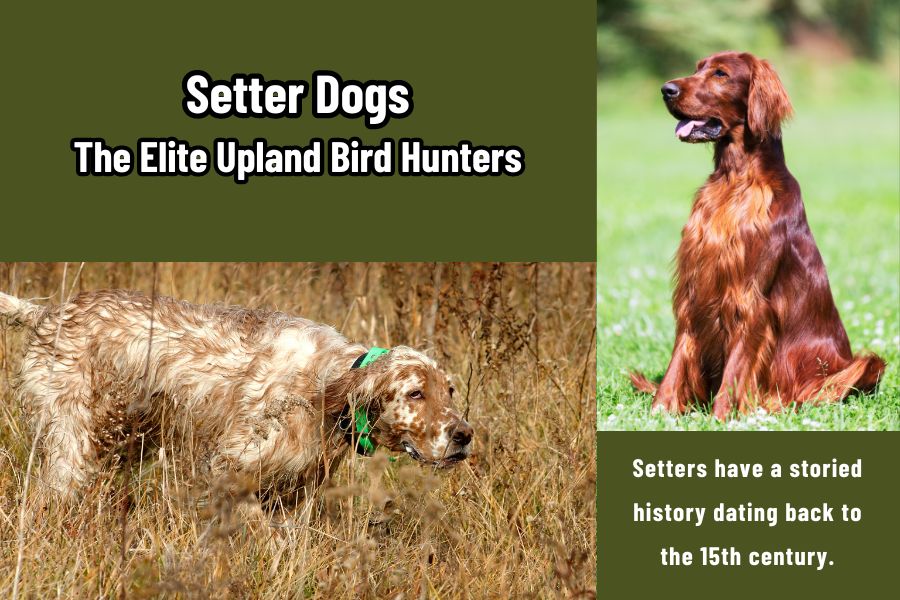Discover the rich history and natural instincts of setter dogs, the elite upland bird hunters. Learn about their unique hunting skills, various breeds, training techniques, and essential care tips on how to best nurture these versatile and loyal companions.
Introduction
Imagine a crisp autumn morning, the sun barely peeking over the horizon, as your loyal companion, a setter dog, moves gracefully through the field. With their keen instincts and elegant stance, setters have captivated hunters for centuries, becoming the elite upland bird hunters they are today.
In this article, we’ll dive deep into the world of setter dogs, exploring their origins, natural instincts, and roles in hunting. We’ll also highlight the different setter breeds, their unique characteristics, and provide valuable training and care tips. Whether you’re an experienced hunter or just getting started, understanding these magnificent dogs can elevate your hunting experience.
Setters have a storied history that dates back to the 15th century, and their legacy continues to thrive today. By unraveling the fascinating journey of setters from their early days to modern times, we’ll connect with the traditions and skills that make them indispensable partners in the field. So, if you’re passionate about hunting or simply intrigued by the allure of these remarkable dogs, this comprehensive guide is for you.
The Natural Instincts of Setter Dogs
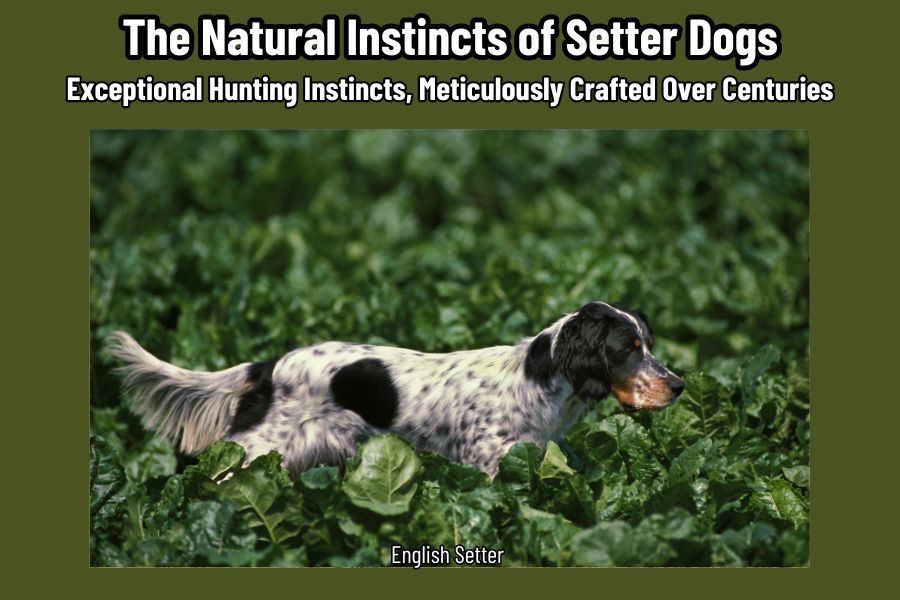
Setters are renowned for their exceptional hunting abilities, a legacy that has been meticulously crafted over centuries. These dogs possess an innate drive and skill set that make them unparalleled in the field. In this section, we’ll delve into the fascinating history and instincts that define setter dogs.
Setters: Origin, History, and Legacy
The origins of setter dogs trace back to the 15th century in the UK, where they were initially bred for their hunting prowess. These early setters were prized for their ability to locate game birds with remarkable precision. As their reputation grew, setters were exported to France and England, and eventually made their way to America. Each country contributed to the development of the distinct setter breeds we recognize today, such as the English Setter, Gordon Setter, and Irish Setter.
Understanding The Setter Instincts
The term “setter” comes from the unique stance these dogs adopt when they detect game. Upon finding their quarry, setters will crouch or “set,” a behavior that is both instinctual and mesmerizing to witness. This distinctive pose signals the presence of game birds to the hunter, allowing for a stealthy approach. These gundogs have a keen sense of smell and an incredible ability to work tirelessly in various terrains, making them indispensable partners in upland bird hunting.
Selectively Bred from Spaniel Dogs
The lineage of modern setters can be traced back to Spain, where they were originally bred from spaniel stock. Spaniels were known for their versatility and hunting skills, traits that were highly sought after by hunters. Over time, selective breeding focused on enhancing specific qualities, such as the ability to scent game at long distances and a steady, reliable disposition. This careful breeding process gave rise to the distinct setter breeds we admire today, each with their own unique strengths and characteristics.
Setter dogs have stood the test of time, evolving from their spaniel ancestors into the elite hunters we know today. Their rich history, combined with their natural instincts and specialized training, makes them invaluable to hunters around the world. Whether you’re chasing pheasants in the Midwest or quail in the South, the bond between a hunter and their setter is one built on trust, skill, and a shared passion for the hunt.
The Role of Setter Dogs
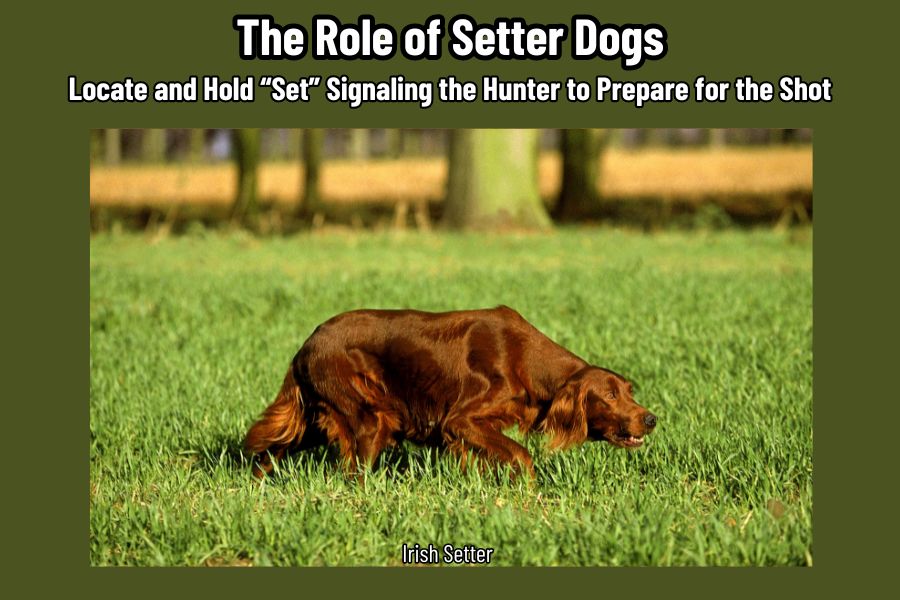
Setter dogs are more than just hunting companions; they’re elite partners in the field, embodying a blend of instinct, training, and dedication. Their role in hunting upland game birds is unparalleled, making them a favorite among hunters who value skill and reliability.
Setters Track, Stalk, and Flush Prey
Setter dogs are renowned for their ability to track, stalk, and flush prey with remarkable precision. These gundogs are indispensable when hunting upland game such as pheasant, quail, and grouse. Picture this: a cool morning, the ground damp with dew, and your setter moving with calculated grace. The dog’s nose works overtime, picking up the faintest scent of a quail hidden in the brush. As the setter narrows in, it adopts its signature crouch, a silent signal to the hunter that the quarry is near. This moment of suspense, the silent communication between dog and hunter, is where the setter’s true value shines.
Why Setters Make Great Hunting Dogs
What sets setter dogs apart is their blend of natural hunting instincts and versatility across various hunting scenarios. These dogs are not just bred for their physical capabilities but also for their temperament and intelligence, making them exceptional bird hunters. Specializing in upland game birds such as quail, pheasant, and grouse, setters excel in both locating and flushing game.
Consider the story of a seasoned hunter and his trusted English Setter, Max. On one hunting trip, Max demonstrated his impeccable tracking ability by leading his owner through a dense thicket to a hidden covey of quail. Not only did Max locate the birds, but his disciplined “set” allowed for a successful, clean flush, giving the hunter a perfect shot.
The hunters success with Max is not an exception, it’s the norm for many setter dogs. These dogs are prized for their strong drive, eager-to-please nature, and high trainability. Their versatility ensures they can adapt to different terrains and hunting styles, making them a reliable and skilled partner in the field.
Setter Dog Breeds: Elegance and Skill
Setter dogs are a remarkable blend of elegance and skill, traits that have been honed over centuries. Recognized by both the American Kennel Club (AKC) and the Canadian Kennel Club (CKC) within the Sporting Group, these breeds stand out for their beauty, intelligence, and exceptional hunting abilities. Let’s explore the unique characteristics of the main setter breeds.
English Setter: The Gentleman’s Bird Dog
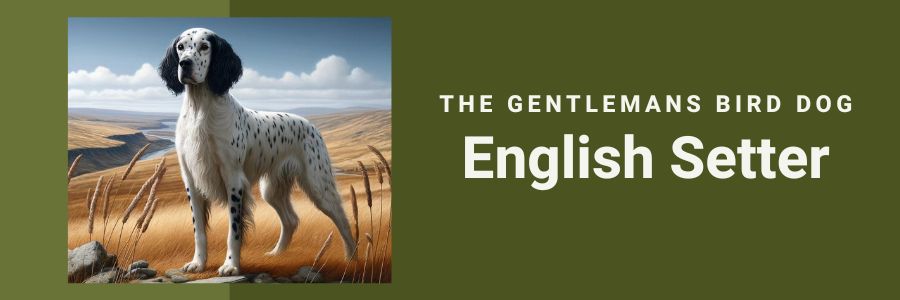
The English Setter, often referred to as the “gentleman’s bird dog,” has a rich history dating back to the 14th century. Developed in England, this breed was originally used for hunting game birds by setting, or crouching low, to avoid detection. Over time, the English Setter has become a beloved companion for hunters and families alike.
Physical Traits Common to English Setter: English Setters are medium to large dogs, typically weighing between 45 to 80 pounds and standing 24 to 27 inches tall. They have a distinctive coat with a mix of colors, including white with black, orange, or brown markings, often referred to as “belton.” Their long, feathery coat requires regular grooming to keep it in top condition. With expressive eyes, a strong sense of smell, and acute hearing, English Setters are built for both beauty and functionality. They are generally healthy, with a life expectancy of 10 to 12 years.
Behavioral Traits Common to English Setter: Known for their versatility and obedience, English Setters are even-tempered and very active. They are playful, patient, and loyal, making them excellent family dogs. Their strong drive and eagerness to please, combined with high trainability, make them superb hunting partners as well.
Gordon Setter: The Stalwart Partners
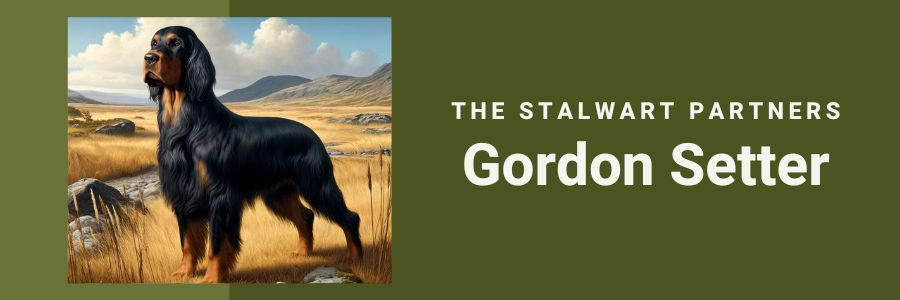
The Gordon Setter, named after the Duke of Gordon who popularized the breed in the 19th century, hails from Scotland. This breed is known for its endurance and reliability in the field, making it a stalwart partner for hunters.
Physical Traits Common to Gordon Setter: Gordon Setters are the largest of the setter breeds, weighing between 55 to 80 pounds and standing 23 to 27 inches tall. They have a distinctive black and tan coat that is thick and slightly wavy, providing protection in rugged terrains. Their sturdy build, coupled with keen senses, makes them excellent trackers. The breed is generally healthy, with a life expectancy of 10 to 12 years.
Behavioral Traits Common to Gordon Setter: Gordon Setters are versatile, obedient, and even-tempered. They are very active, playful, and patient, traits that make them great with families. Their loyalty, strong drive, and eagerness to please make them highly trainable and dependable in hunting scenarios.
Irish Setter: The Red-Hued Hunters
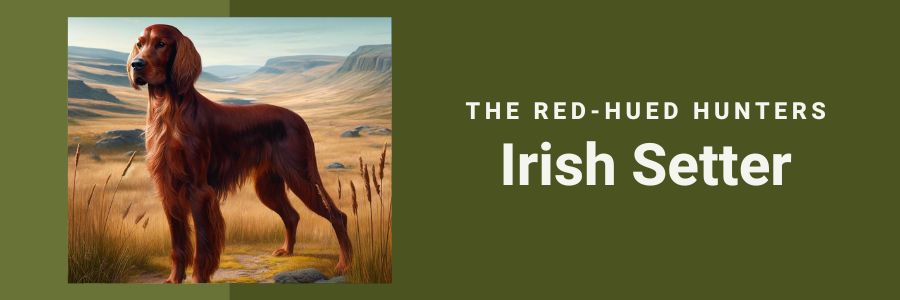
The Irish Setter, known for its vibrant red coat, is one of the most distinctive setter breeds. This breed, which began to take shape in Ireland around 1845, initially featured a variety of colors, including darker red, red and white, lemon, or white with deep chestnut patches. However, there was a growing preference for solid red coats, which influenced the typical look of Irish-bred setters. The Irish Setter made its way to the United States in the early 19th century..
Physical Traits Common to Irish Setter: Irish Setters are elegant dogs, weighing between 60 to 70 pounds and standing 25 to 27 inches tall. Their deep chestnut red coat is long and silky, requiring regular grooming to maintain its luster. With an athletic build, sharp senses, and a keen sense of smell, they are well-suited for hunting. The breed enjoys good health and has a life expectancy of 12 to 15 years.
Behavioral Traits Common to Irish Setter: Irish Setters are versatile, obedient, and even-tempered. They are highly active, playful, and patient, making them great companions for families and hunters alike. Known for their strong drive and eagerness to please, they are highly trainable and excel in various hunting environments.
Irish Setter Red and White: Powerful but Vulnerable
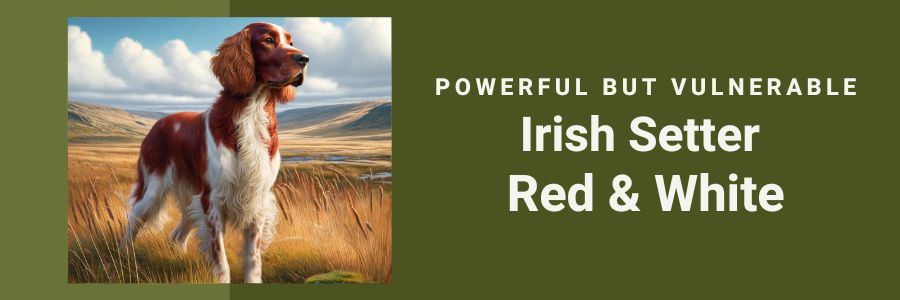
In the early 1800s, setters in Ireland came in various colors, including mostly red, red and white, or predominantly white. These dogs were all considered Irish Setters and were bred with each other. However, the solid red Irish Setter gained significant popularity in both America and Ireland, fetching high prices and leading to the near extinction of the Irish Red and White Setter. Dedicated breeders in remote areas of Ireland managed to preserve the breed. Thanks to the restoration efforts, the breed has been preserved, though it remains vulnerable.
The American Kennel Club (AKC) officially recognized the Irish Red and White Setter in January 2009, while the Canadian Kennel Club granted recognition in May 1999.
Physical Traits Common to Irish Red and White Setter: These setters weigh between 50 to 70 pounds and stand 22 to 26 inches tall. They have a striking red and white coat that is shorter and less silky than the Irish Setter’s but equally beautiful. Their build is athletic, with strong senses and a keen nose, making them effective hunters. The breed is generally healthy, with a life expectancy of 12 to 15 years.
Behavioral Traits Common to Irish Red and White Setter: Irish Red and White Setters are versatile, obedient, and even-tempered. They are very active, playful, and patient, making them suitable for families and hunting alike. Their loyalty, strong drive, and eagerness to please ensure they are highly trainable and perform well in various hunting scenarios.
Training Setter Dogs: Basic and Advanced Techniques
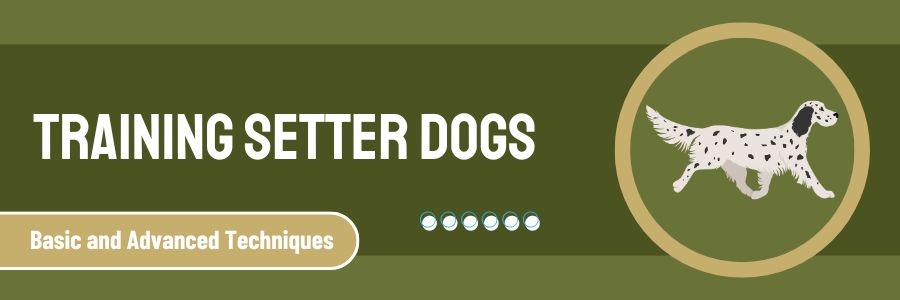
Training setter dogs requires patience, consistency, and an understanding of their natural instincts and history. Whether you’re nurturing a young pup or refining the skills of an experienced hunter, effective training can turn a good dog into a great one.
Early Basic Training Techniques
To nurture the natural hunting instincts of setter dogs, it’s crucial to start with a foundation that respects their heritage. Understanding your dog’s history and bloodline can offer valuable insights. If your setter comes from a lineage of accomplished hunters, leveraging those inherited traits can enhance training outcomes. In addition, consult with your dogs breeder, learning how your dog’s parents were trained can provide a roadmap for your own training efforts.
Begin with basic commands like “sit,” “stay,” and “come.” These commands build a foundation of obedience and establish you as the leader. Early exposure to hunting environments is essential. Introduce your puppy to the sights, sounds, and smells they’ll encounter in the field. Take them on short walks in fields or forests to stimulate their senses and encourage exploration.
Advanced Training Techniques
Advanced training for setter dogs involves honing their natural abilities and introducing them to real hunting scenarios. One effective way to advance your dog’s training is by attending hunts with experienced setters. This exposure allows your dog and you to observe and learn from seasoned hunters, providing invaluable real-world experience.
Set clear goals for your training. Decide on the specific skills and behaviors you want to develop, such as tracking, setting, and flushing. Expose your dog to the game birds you plan to hunt. This exposure helps them become familiar with the scent and behavior of these birds, making them more effective in the field.
Research and choose a training method that suits both you and your dog. Many trainers use the “whoa” training method, which involves teaching the dog to stop and stay still on command, often using a barrel for balance and focus. This technique works with some dogs but keep in mind it’s not one method works for all dogs.
Commit to a consistent training schedule. Repetition is key to reinforcing desired behaviors and building muscle memory. Training your dog will not be an easy process, and there will be setbacks. Patience and persistence are essential.
Consider hiring a professional bird dog trainer if you’re struggling or if your dog has specific challenges. However, stay involved in the process. Training is an opportunity to build a deep bond with your dog, rooted in trust and mutual respect. Enjoy the journey and celebrate the small victories along the way.
Caring for Your Setter

Proper care for setter dogs ensures they remain healthy, happy, and ready for the field. From tailored nutrition to regular health check-ups, and fostering a deep connection, here’s how you can provide the best care for your setter.
Nutritional Guidelines
Setter dogs are active and energetic, requiring a diet that supports their lifestyle. Providing high-quality, protein-rich food is essential. Protein supports muscle development and maintenance, crucial for a breed that’s constantly on the move. Look for dog food with real meat as the first ingredient, supplemented with healthy fats and essential vitamins.
An interesting fact: the ancestors of modern setters were often fed a diet rich in game meat, reflecting their role as hunting dogs. You can mirror this with lean meats like chicken or turkey. Additionally, incorporate complex carbohydrates like sweet potatoes and brown rice to give your setter sustained energy throughout the day.
Keep an eye on portion sizes to prevent overfeeding, which can lead to obesity. Obesity can strain your dog’s joints and overall health, reducing their effectiveness in the field. Always ensure your dog has access to fresh water, especially after vigorous activity.
Regular Health Check-ups
Routine veterinary visits are crucial for maintaining your setter’s health. Regular check-ups can catch potential health issues early, ensuring timely treatment. Vaccinations are a key part of preventive care, protecting your dog from common diseases.
Setter dogs are prone to certain breed-specific health concerns, such as hip dysplasia and ear infections. Hip dysplasia, a genetic condition where the hip joint doesn’t fit properly, can be managed with early detection and appropriate care. Regular exercise and maintaining a healthy weight can also help mitigate the symptoms.
Ear infections are common due to their long, floppy ears, which can trap moisture and debris. Clean your dog’s ears regularly with a vet-recommended solution to prevent infections. Watch for signs like excessive scratching or head shaking, which may indicate an issue.
Fostering a Deep Connection
The bond between a hunter and their setter dog is special, built on trust, mutual respect, and companionship. Setters are loyal and eager to please, forming strong attachments with their owners.
Spend quality time with your dog both in and out of hunting scenarios. Training sessions, playtime, and simple walks can strengthen your relationship. Consistency and positive reinforcement in training help build trust. Celebrate your dog’s successes and be patient with setbacks.
Remember, the time and effort you invest in bonding with your dog will be returned tenfold in loyalty and performance.
Conclusion
Setter dogs are the epitome of elegance and skill in upland bird hunting, combining rich history, natural instincts, and exceptional versatility. Throughout this article, we’ve explored the origins and legacy of setters, their distinct hunting abilities, and the unique characteristics of different setter breeds such as the English, Gordon, Irish, and Irish Red and White Setters. We’ve delved into training techniques that range from nurturing natural instincts to advanced methods for seasoned hunters, and we’ve covered essential care practices to ensure your setter remains healthy and ready for the field.
These loyal and skilled companions bring a unique blend of dedication and instinct to hunting, making them invaluable partners. Whether you’re training a new pup or refining the skills of an experienced dog, the bond you build with your setter is one of trust and mutual respect. Embrace the journey of working with setter dogs, and you’ll find a hunting experience that is both rewarding and unforgettable.
FAQs: Setter Dogs
The following FAQs cover some of the common questions about setter dogs.
Are Setters easy to train?
Setter Dogs Answer:
Yes, setters are generally easy to train due to their intelligence and eagerness to please. Consistency and positive reinforcement are key. Early socialization and training will help them develop good habits and manners. Their natural hunting instincts can be effectively harnessed with proper training techniques.
Are Setters good family dogs?
Setter Dogs Answer:
Absolutely. Setters are known for their friendly and gentle temperament, making them excellent family dogs. They are great with children and can adapt well to family life. Their playful and patient nature, combined with their loyalty, ensures they bond deeply with their human companions. Keep in mind, if you want a hunting dog as well as a family dog, it’s imperative that you train and hunt on a regular basis. You cannot expect your dog to perform well in the field if you only hunt once a year.
Why are Irish Setters good hunting dogs?
Setter Dogs Answer:
Irish Setters make excellent hunting dogs. This setter breed is renowned for its keen sense of smell and speed, which make them adept at tracking, setting, flushing, and even retrieving game. They are focused, move with elegance and purpose, and are particularly known as one of the best bird hunting dogs.
Why are Irish Red and White Setters good hunting dogs?
Setter Dogs Answer:
Irish Red and White Setters are prized for their versatility and stamina in hunting situations. Their physical strength and mental sharpness make them exceptional hunting companions. The breed boasts well-developed muscles in the neck, chest, and hindquarters, allowing them to move with both grace and power in the field.
Why are Gordon Setters good hunting dogs?
Setter Dogs Answer:
Gordon Setters are renowned for their stamina and determination in the field. Their larger size and muscular build enable them to navigate tough terrains with ease. They have a keen sense of smell and are particularly effective in tracking and pointing game birds. Their loyalty and reliability make them steadfast hunting partners.
Why are English Setters good hunting dogs?
Setter Dogs Answer:
English Setters are prized for their versatility and grace in hunting. They possess a unique combination of endurance, agility, and a keen sense of smell. Known for their “set” stance upon finding game, they are effective in signaling the presence of birds. Their even-tempered and trainable nature ensures they perform well under various hunting conditions.
Resources: Setter Dogs
These resources offer a wealth of information for anyone interested in setter dogs, from history, care, training tips to breed-specific insights.
SPECIAL NOTE: “The information provided in this post about pointing dogs is based on research using the Resource links listed below. While we try to keep the information for this post current, there are no representations expressed or implied, about the completeness, or accuracy of the information provided. Therefore all hunters should always verify current information from these resources along with other local and federal publications”.
Online Resources
- AKC – American Kennel Club
- TKC – The Kennel Club
- UKC – United Kennel Club
- CKC – Canadian Kennel Club
Books
- “The Complete English Setter” by J. Evans
- A comprehensive guide covering the history, training, and care of English Setters.
- “Irish Setters: A Complete Pet Owner’s Manual” by Nikki Riggsbee
- This book provides detailed information on the care, training, and history of Irish Setters.
- “The Gordon Setter: History, Training, Care, and Health” by N. D. W. Phipps
- An in-depth look at the Gordon Setter, including its origins, training methods, and health care.
- “Training the Setter” by David Hudson
- A focused guide on training setters, with practical advice and techniques for hunters and dog owners.
- “Irish Red and White Setters: A Comprehensive Guide to Owning and Caring for Your Dog” by Tracey Birnhak
- A thorough resource for anyone interested in the Irish Red and White Setter, covering everything from training to health care.

